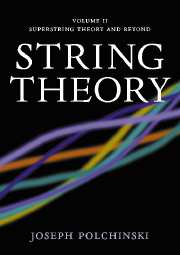Book contents
- Frontmatter
- Contents
- Foreword
- Preface
- Notation
- 10 Type I and type II superstrings
- 11 The heterotic string
- 12 Superstring interactions
- 13 D-branes
- 14 Strings at strong coupling
- 15 Advanced CFT
- 16 Orbifolds
- 17 Calabi–Yau compactification
- 18 Physics in four dimensions
- 19 Advanced topics
- Appendix B Spinors and SUSY in various dimensions
- References
- Glossary
- Index
12 - Superstring interactions
Published online by Cambridge University Press: 26 February 2010
- Frontmatter
- Contents
- Foreword
- Preface
- Notation
- 10 Type I and type II superstrings
- 11 The heterotic string
- 12 Superstring interactions
- 13 D-branes
- 14 Strings at strong coupling
- 15 Advanced CFT
- 16 Orbifolds
- 17 Calabi–Yau compactification
- 18 Physics in four dimensions
- 19 Advanced topics
- Appendix B Spinors and SUSY in various dimensions
- References
- Glossary
- Index
Summary
In this chapter we will examine superstring interactions from two complementary points of view. First we study the interactions of the massless degrees of freedom, which are highly constrained by supersymmetry. The first section discusses the tree-level interactions, while the second discusses an important one-loop effect: the anomalies in local spacetime symmetries. We then develop superstring perturbation theory. We introduce superfields and super-Riemann surfaces to give superconformal symmetry a geometric interpretation, and calculate a variety of tree-level and one-loop amplitudes.
Low energy supergravity
The ten-dimensional supersymmetric string theories all have 32 or 16 supersymmetry generators. This high degree of supersymmetry completely determines the low energy action.
Type IIA superstring
We begin by discussing the field theory that has the largest possible spacetime supersymmetry and Poincaré invariance, namely eleven-dimensional supergravity. As explained in the appendix, the upper limit on the dimension arises because nontrivial consistent field theories cannot have massless particles with spins greater than two.
This theory would seem to have no direct connection to superstring theory, which requires ten dimensions. Our immediate interest in it is that, as discussed in section B.5, its supersymmetry algebra is the same as that of the IIA theory. The action of the latter can therefore be obtained by dimensional reduction, toroidal compactification keeping only fields that are independent of the compact directions. For now this is just a trick to take advantage of the high degree of supersymmetry, but in chapter 14 we will see that there is much more going on.
- Type
- Chapter
- Information
- String Theory , pp. 84 - 135Publisher: Cambridge University PressPrint publication year: 1998



